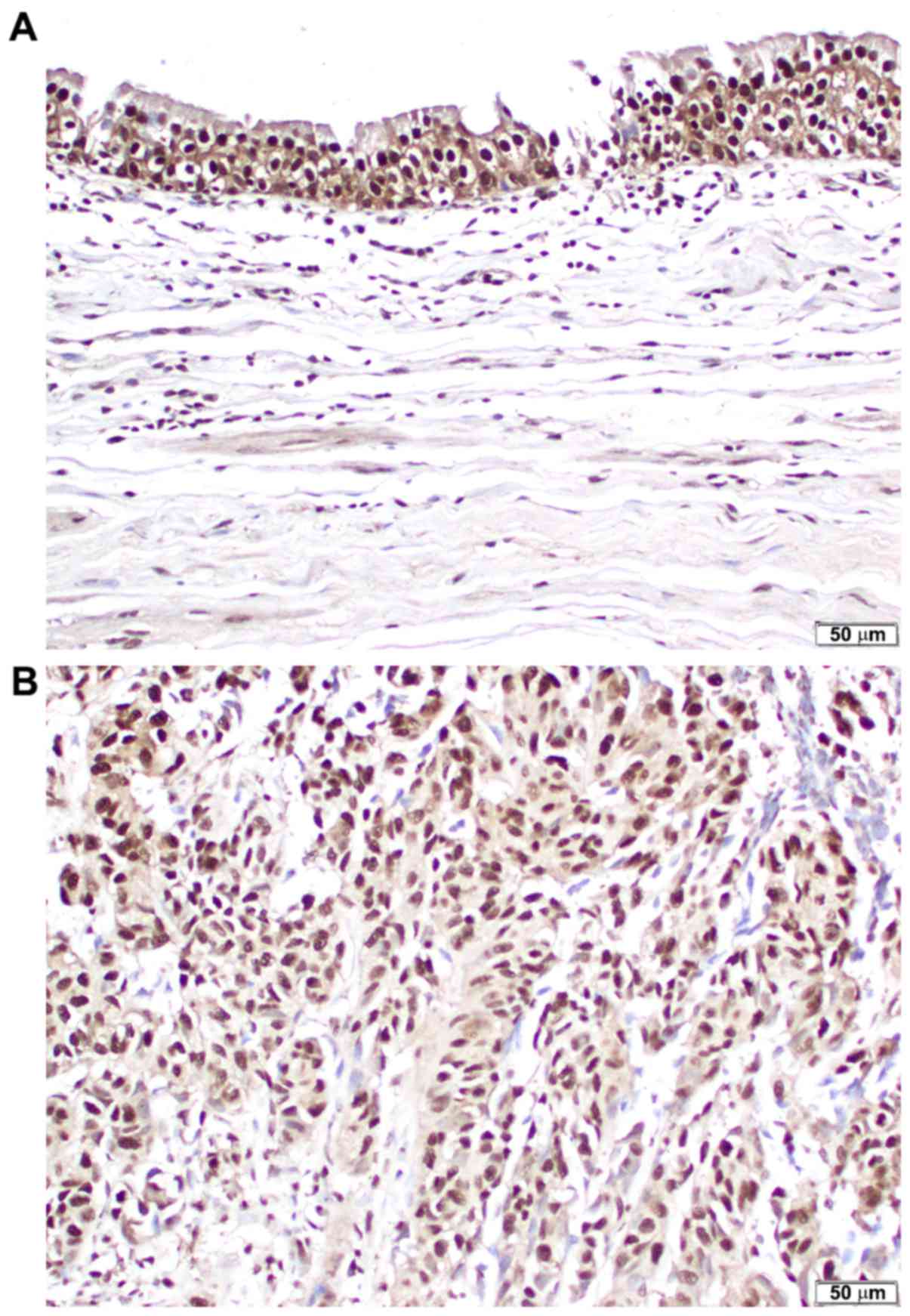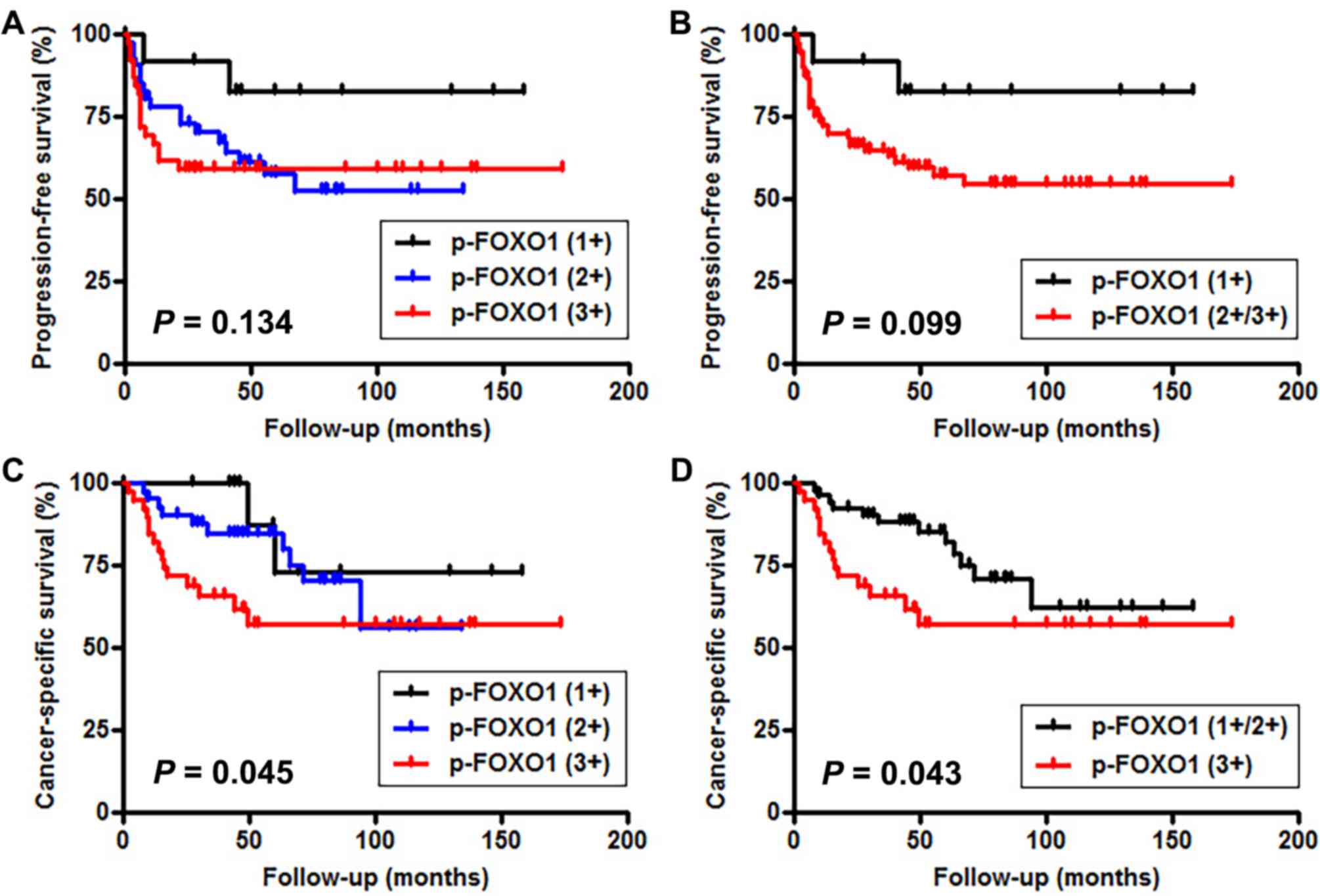|
1
|
Oya M and Kikuchi E; Committee for
Establishment of Clinical Practice Guideline for Management of
Upper Tract Urothelial Carcinoma and Japanese Urological
Association, . Evidenced-based clinical practice guideline for
upper tract urothelial carcinoma (summary-Japanese Urological
Association, 2014 edition). Int J Urol. 22:3–13. 2015. View Article : Google Scholar : PubMed/NCBI
|
|
2
|
Rouprêt M, Babjuk M, Compérat E, Zigeuner
R, Sylvester RJ, Burger M, Cowan NC, Böhle A, Van Rhijn BW,
Kaasinen E, et al: European association of urology guidelines on
upper urinary tract urothelial cell carcinoma: 2015 update. Eur
Urol. 68:868–879. 2015. View Article : Google Scholar : PubMed/NCBI
|
|
3
|
Chromecki TF, Bensalah K, Remzi M,
Verhoest G, Cha EK, Scherr DS, Novara G, Karakiewicz PI and Shariat
SF: Prognostic factors for upper urinary tract urothelial
carcinoma. Nat Rev Urol. 8:440–447. 2011. View Article : Google Scholar : PubMed/NCBI
|
|
4
|
Lughezzani G, Burger M, Margulis V, Matin
SF, Novara G, Roupret M, Shariat SF, Wood CG and Zigeuner R:
Prognostic factors in upper urinary tract urothelial carcinomas: A
comprehensive review of the current literature. Eur Urol.
62:100–114. 2012. View Article : Google Scholar : PubMed/NCBI
|
|
5
|
Krabbe LM, Heitplatz B, Preuss S,
Hutchinson RC, Woldu SL, Singla N, Boegemann M, Wood CG, Karam JA,
Weizer AZ, et al: Prognostic value of PD-1 and PD-L1 expression in
patients with high grade upper tract urothelial carcinoma. J Urol.
198:1253–1262. 2017. View Article : Google Scholar : PubMed/NCBI
|
|
6
|
Nakamura N, Ramaswamy S, Vazquez F,
Signoretti S, Loda M and Sellers WR: Forkhead transcription factors
are critical effectors of cell death and cell cycle arrest
downstream of PTEN. Mol Cell Biol. 20:8969–8982. 2000. View Article : Google Scholar : PubMed/NCBI
|
|
7
|
Coomans de Brachène A and Demoulin JB:
FOXO transcription factors in cancer development and therapy. Cell
Mol Life Sci. 73:1159–1172. 2016. View Article : Google Scholar : PubMed/NCBI
|
|
8
|
Guo Y, Liu H, Zhang H, Shang C and Song Y:
miR-96 regulates FOXO1-mediated cell apoptosis in bladder cancer
cells. Oncol Lett. 4:561–565. 2012. View Article : Google Scholar : PubMed/NCBI
|
|
9
|
Jiang G, Wu AD, Huang C, Gu J, Zhang L,
Huang H, Liao X, Li J, Zhang D, Zheng X, et al: Isorhapontigenin
(ISO) inhibits invasive bladder cancer formation in vivo and human
bladder cancer in vitro by targeting STAT1/FOXO1 axis. Cancer Prev
Res. 9:567–580. 2016. View Article : Google Scholar
|
|
10
|
Huang H, Muddiman DC and Tindall DJ:
Androgens negatively regulate forkhead transcription factor FKHR
(FOXO1) through a proteolytic mechanism in prostate cancer cells. J
Biol Chem. 279:13866–13877. 2004. View Article : Google Scholar : PubMed/NCBI
|
|
11
|
Nakajima Y, Akaogi K, Suzuki T, Osakabe A,
Yamaguchi C, Sunahara N, Ishida J, Kato K, Ogawa S, Fujimura T, et
al: Estrogen regulates tumor growth through a nonclassical pathway
that includes the transcription factors ERβ and KLF5. Sci Signal.
4:ra222011. View Article : Google Scholar : PubMed/NCBI
|
|
12
|
Miyamoto H, Zheng Y and Izumi K: Nuclear
hormone receptor signals as new therapeutic targets for urothelial
carcinoma. Curr Cancer Drug Tar. 12:14–22. 2012. View Article : Google Scholar
|
|
13
|
Hsu I, Vitkus S, Da J and Yeh S: Role of
oestrogen receptors in bladder cancer development. Nat Rev Urol.
10:317–326. 2013. View Article : Google Scholar : PubMed/NCBI
|
|
14
|
Inoue S, Mizushima T and Miyamoto H: Role
of the androgen receptor in urothelial cancer. Mol Cell Endocrinol.
465:73–81. 2018. View Article : Google Scholar : PubMed/NCBI
|
|
15
|
Kim TH, Jo SW, Lee YS, Kim YJ, Lee SC, Kim
WJ and Yun SJ: Forkhead box O-class 1 and forkhead box G1 as
prognostic markers for bladder cancer. J Korean Med Sci.
24:468–473. 2009. View Article : Google Scholar : PubMed/NCBI
|
|
16
|
Lloreta J, Font-Tello A, Juanpere N,
Frances A, Lorenzo M, Nonell L, de Muga S, Vázquez I, Cecchini L
and Hernández-Llodrà S: FOXO1 down-regulation is associated with
worse outcome in bladder cancer and adds significant prognostic
information to p53 overexpression. Hum Pathol. 62:222–231. 2017.
View Article : Google Scholar : PubMed/NCBI
|
|
17
|
Zhang Y, Jia L, Zhang Y, Ji W and Li H:
Higher expression of FOXOs correlates to better prognosis of
bladder cancer. Oncotarget. 8:96313–96322. 2017.PubMed/NCBI
|
|
18
|
Munari E, Fujita K, Faraj S, Chaux A,
Gonzalez-Roibon N, Hicks J, Meeker A, Nonomura N and Netto GJ:
Dysregulation of mammalian target of rapamycin pathway in upper
tract urothelial carcinoma. Hum Pathol. 44:2668–2676. 2013.
View Article : Google Scholar : PubMed/NCBI
|
|
19
|
Eble JN, Sauter G, Epstein JI and
Sesterhenn IA: World Health Organization Classification of Tumours.
Pathology and Genetics of Tumours of the Urinary System and Male
Genital Organs. IARC Press; Lyon: 2004
|
|
20
|
Kashiwagi E, Fujita K, Yamaguchi S,
Fushimi H, Ide H, Inoue S, Mizushima T, Reis LO, Sharma R, Netto
GJ, et al: Expression of steroid hormone receptors and its
prognostic significance in urothelial carcinoma of the upper
urinary tract. Cancer Biol Ther. 17:1188–1196. 2016. View Article : Google Scholar : PubMed/NCBI
|
|
21
|
Chai H and Brown RE: Field effect in
cancer-An update. Ann Clin Lab Sci. 39:331–337. 2009.PubMed/NCBI
|
|
22
|
Mazumdar A and Kumar R: Estrogen
regulation of Pak1 and FKHR pathways in breast cancer cells. FEBS
Lett. 535:6–10. 2003. View Article : Google Scholar : PubMed/NCBI
|
|
23
|
Inoue S, Mizushima T, Fujita K, Meliti A,
Ide H, Yamaguchi S, Fushimi H, Netto GJ, Nonomura N and Miyamoto H:
GATA3 immunohistochemistry in urothelial carcinoma of the upper
urinary tract as a urothelial marker as well as a prognosticator.
Hum Pathol. 64:83–90. 2017. View Article : Google Scholar : PubMed/NCBI
|
|
24
|
Jalalizadeh M, Inoue S, Fujita K, Ide H,
Mizushima T, Yamaguchi S, Fushimi H, Nonomura N and Miyamoto H:
ZKSCAN3 expression in urothelial carcinoma of the upper urinary
tract and its impact on patient outcomes. Integr Cancer Sci Ther.
4:10002412017.
|
|
25
|
Kawahara T, Inoue S, Fujita K, Mizushima
T, Ide H, Yamaguchi S, Fushimi H, Nonomura N and Miyamoto H: NFATc1
expression as a prognosticator in urothelial carcinoma of the upper
urinary tract. Transl Oncol. 10:318–323. 2017. View Article : Google Scholar : PubMed/NCBI
|
|
26
|
Inoue S, Ide H, Fujita K, Mizushima T,
Jiang G, Kawahara T, Yamaguchi S, Fushimi H, Nonomura N and
Miyamoto H: Expression of phospho-ELK1 and its prognostic
significance in urothelial carcinoma of the upper urinary tract.
Int J Mol Sci. 19:e7772018. View Article : Google Scholar : PubMed/NCBI
|
















